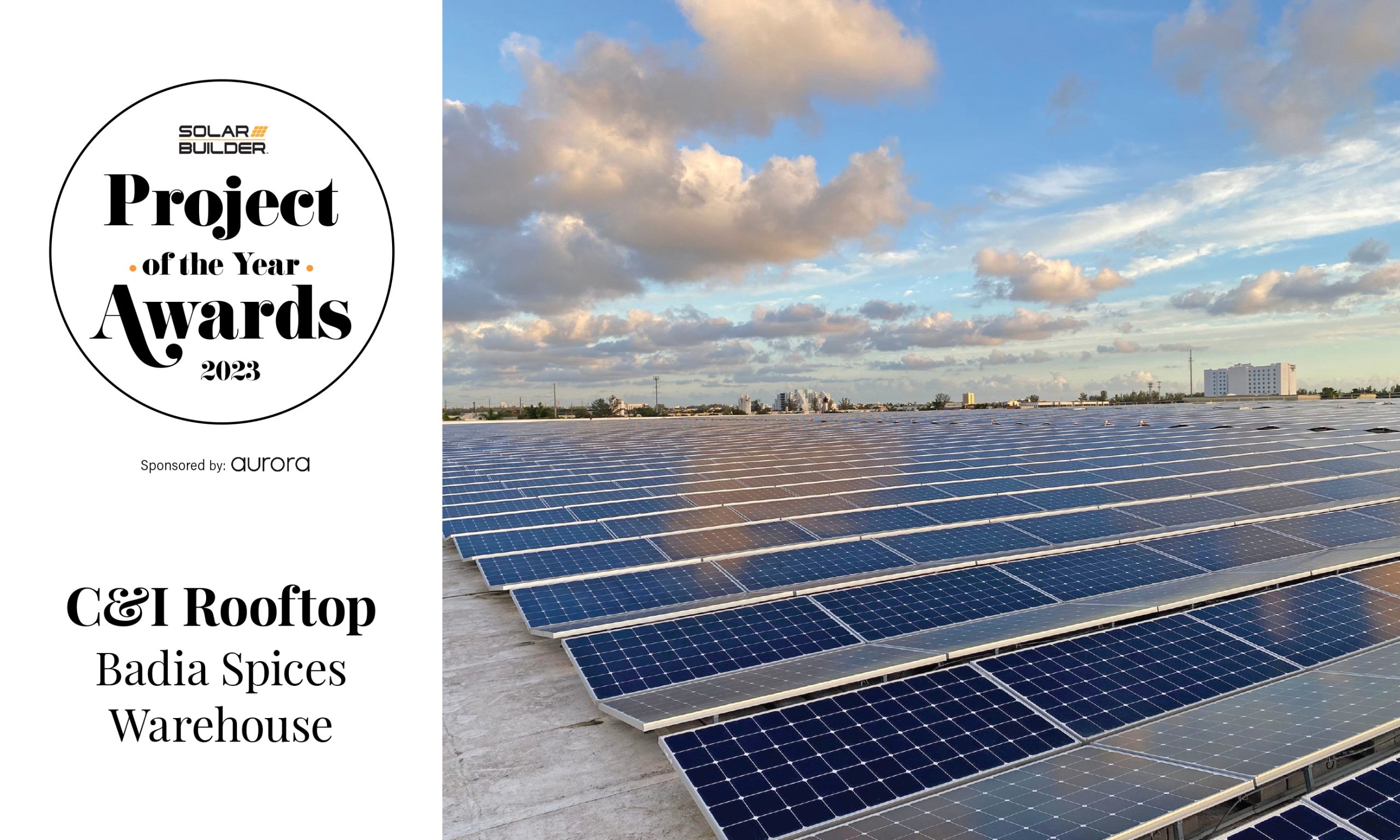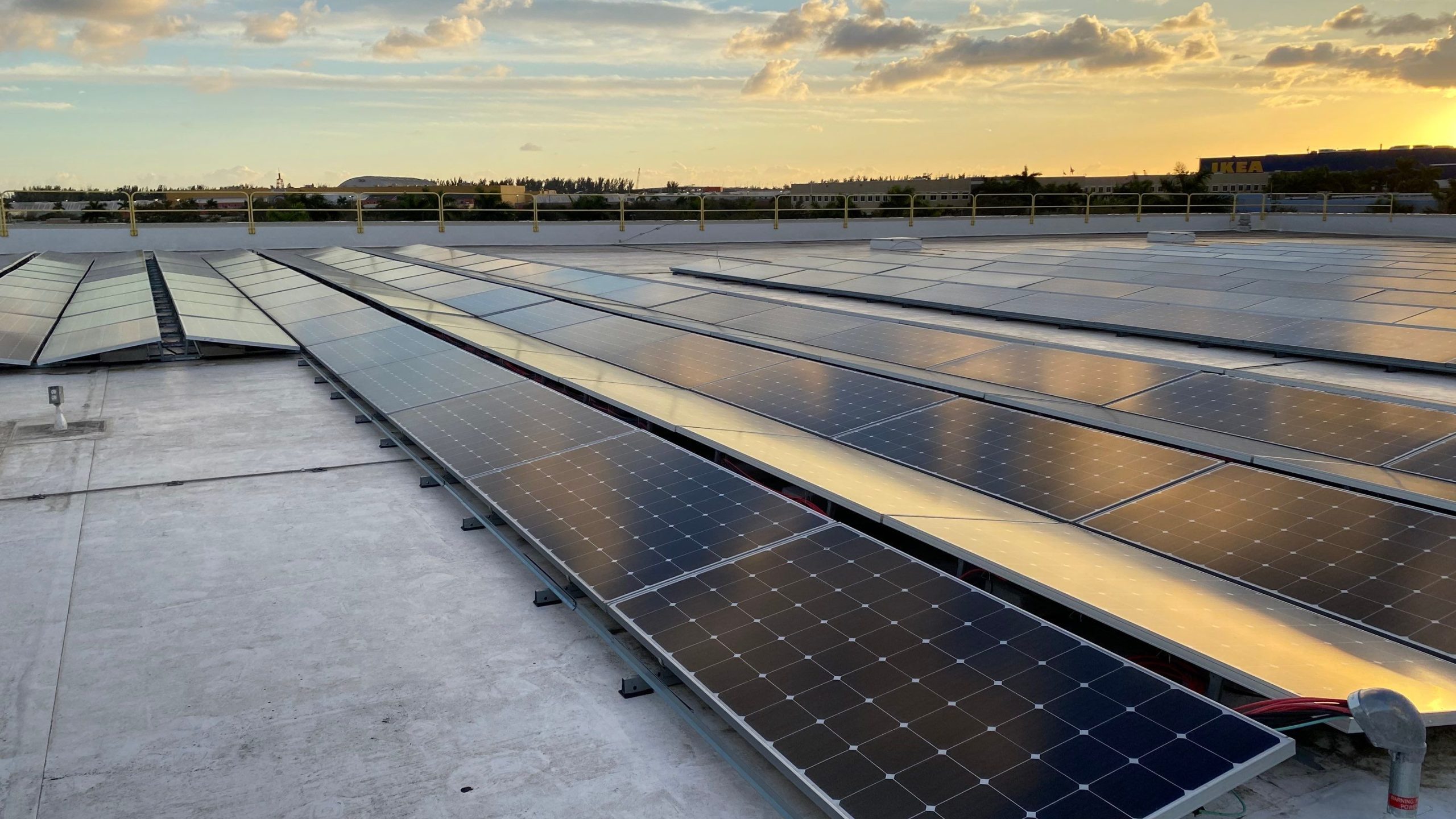
Badia Spices Warehouse
Sweetwater, Fla. | 3.24 MW
The 2023 C&I Rooftop Solar Project of the Year, as voted by the readers of Solar Builder, is the Badia Spices Warehouse in Sweetwater, Fla. Engineered and installed by SALT Energy, this self-financed solar project is the largest privately owned solar project in Florida as of August 2023. This gets bonus points for being located in Miami-Dade County, which has the most stringent engineering requirements for solar in the country due to hurricane wind loads.
Self-financing a project of this size is uncommon, but Joseph “Pepe” Badia, founder of Badia Spices, isn’t your common business owner. He’s in his 80s, but still very much focused on the future.
Project Details
Developer: Badia Spices
EPC/Installer: SALT Energy
Modules: SunPower
Inverters: SMA America
Mounting/Racking: PanelClaw
“This is my third rodeo with David,” Badia notes, detailing his long-term partnership with SALT Energy and its VP David Kaul. SALT installed solar on Badia’s home eight years ago. In April 2019, SALT Energy added a 529 kWdc rooftop system at Badia’s 100,000 sq ft warehouse in Doral, Fla.
“It added value to the property immensely; we brag about this to our customers,” Badia says, name dropping Publix, Walmart, ShopRite and Kroger as examples. “Every time we make a presentation, this is front and center because these projects show we are being good citizens of the future. It speaks volumes for us.”
A dash of SALT
When Badia was ready to make this bigger investment, he knew where to turn.
“We have so much faith in David,” Badia says. “We hire contractors to do projects and this and that, but David is a different dude. He has a little bit of hippie in him. A very honest, very straight person, and I highly recommend him. … We learn more from [SALT] because David doesn’t walk away. He keeps track of our performance and sends us reports, and it is fantastic. It was the best thing we ever did.”
Kaul deflects much of the praise, instead heaping it on Badia for being that ideal, motivated C&I solar customer. But building and sustaining a solar business in South Florida does demand a certain baseline of quality.
“It is one of the most challenging places to get the engineering right for solar installations,” Kaul reminds. “And all the clientele are more challenging because they expect high quality in every aspect of what they purchase. So, the Keys and Miami have been a great training ground for us to develop our brand, which is focused on delivering long-term value for customers in the most technically challenging locations.”
To make PV attachment even more difficult on this project, Badia specified no roof penetrations to preserve the roof membrane warranty.
SALT leaned on PanelClaw and Anchor Products for their expertise here, as well as ASCE 7 wind tunnel engineering-based designs. The wind tunnel procedure in ASCE 7 is considered to produce the most accurate wind pressures of any method of structural design, essential for getting the hurricane resilient engineering right.


Winning recipe
SALT’s forecast for the Badia Spices warehouse showed an IRR of 13.8 years, with a payback of around seven years — offsetting approximately 80% of the facility’s electricity consumption.
So far, so good: “I think we are doing a little better, possibly because Florida Power & Light raised rates a little bit,” Kaul says. “It’s going to offset about $450,000 for Pepe this year. The new payback is 6.8 years from what I just saw.”
All of this required forethought.
“We split the system to feed two meters under two 1.25 MW Tier-3 agreements,” Kaul says. “We are actually accumulating kilowatt hour credits on both sides. At the end of the year, Pepe is going to get a check because we actually have been selling back a little bit of electricity every single month on both meters because production [in the warehouse] has not fully ramped up yet.”
Starting from scratch
Given the history, this Badia Spices project was on SALT’s radar from the moment Badia acquired the building. The facility was going to be remodeled to convert it from more of an office building to a production facility. As part of the remodel, Kaul suggested several ways to make the solar production more viable.
Keeping the roof free. “I shared with the Badia management team how much of a benefit it could be for the solar if we didn’t sprinkle air conditioning units all over the rooftop like is often done, and Pepe took that idea and ran with it.” This led Badia to go with a chiller system located on the ground. “Pepe analyzed quotes from several suppliers, and he liked the economics as well, so it was an easy decision with multiple benefits.”
Tie-in opportunity. The planned upgrades for a production facility meant a ton of new load. This required adding two transformers — 1,500 kVA and 2,000 kVA — to bring all new feeds into the building to serve new loads. The solar PV was only connected to these new feeds.
“That was an opportunity because the electrical tie-in for something of this size is a big deal,” Kaul explains. And it turns out SALT had previously worked with the electrical contractor installing the transformers and new load centers. “I talked to him about the concerns I had about backfeeding through the switchgear and the main distribution system that he was installing. Out of those conversations, we decided to upsize the busbars for all the main switchgear so that we could put the solar breakers right on the busbars.
“That’s unusual unless you have forethought to design the switchgear in order to take solar directly. So, that was a big win for us.”
Bringing the inverters indoors. The dc system consists of 40 CORE1 SMA inverters. “We selected a place for the inverters that was located on a mezzanine as part of the new construction,” Kaul says. “We were able to bring all the inverters inside to the climate-controlled space, which is our preference but not always possible on a retrofit. That was a big win. There is nothing on the roof except 40 weatherheads feeding the dc power into the building, meaning, there are no conduits cluttering the roof like typical installations would have.”
Add it all up, and this is likely the cleanest-looking rooftop solar project you’ll ever see.
“It was all because we could work collaboratively with a trusted client to plan ahead,” Kaul says.





